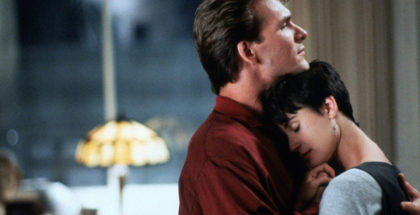VOD film review: Sicilian Ghost Story
Review Overview
Sicilian(s)
8Ghost(s)
8Story
6Rachel Bowles | On 03, Aug 2018
Director: Antonio Piazza, Fabio Grassadonia
Cast: Julia Jedlikowska, Gaetano Fernandez
Certificate: 15
Watch Sicilian Ghost Story online in the UK: All 4 / Curzon Home Cinema / Apple TV (iTunes) / Prime Video (Buy/Rent)
Fairy tales often have at least a kernel of truth to them, grappling with fearful realities so horrifying that it’s best to face them with magic or at least deal with them through a distancing cloak of unreality. Fabio Grassadonia and Antonio Piazza’s sophomore feature, Sicilian Ghost Story, a gothic, oneiric love story, is no different. The kernel here is the unthinkable tragedy of real life Giuseppe di Matteo, a young boy kidnapped by the mafia in the 1990s as a bargaining chip against his mafioso-turned-police-informant father and held prisoner for 779 days. What happened to him is explained briefly and matter-of-factly on a single title card after the film’s ending, a gut punch that, given the film’s joie de vivre and fantasy world, may even feel exploitative.
This is not the directors’ intention, however. Growing up in Sicily around the same time as real life Giuseppe, both Grassadonia and Piazza remember the events well and the way they affected Sicilian society. As well, of course, as the Mafia’s disgusting actions, police and civilians were very much complicit, and the Mafioso omerta (code of silence) meant minding one’s own business at any cost. After the horrendous details of Giuseppe’s captivity came to light, centuries of roots and respect for the Mafia in Sicily were lost. The child’s mother said afterwards Giuseppe had won – this forgotten, stolen child managed to achieve what no anti-corruption campaign could. His fate held up a grisly mirror to the actions of otherwise rational, reasonable adults, and Italians said to themselves, and to each other, never again.
Grassadonia and Piazza realised, however, that as they aged, the younger generation of Sicily had begun to forget Giuseppe. “We talked about making a film about him, as a kind of testament, as an act of love for him, but the story is too horrible,” explained the directors in an interview. “It is a story without any possible catharsis or redemption. Not for the victim, not for anyone. And you need this for cinema.” Cinema, however, is a fantastical way of processing trauma, and Grassadonia and Piazza wanted to give Giuseppe what he was robbed of – his adolescence, his first love, those magical, formative years of growing into adulthood.
This inspired them to create the fictional Giuseppe. Handsome, earnest and full of life, he is played by newcomer Gaetano Fernandez, whose youthful good looks recall a younger, less angsty Timothée Chalamet of Call Me By Your Name and Lady Bird fame. His first love, the day dreaming, more pensive Luna, is played by the also debuting Julia Jedlikowska. Both performances are believable and pitch perfect, with Luna being the anchor at the centre of the narrative. Sicilian Ghost Story opens with Luna following Giuseppe into a forest, one populated by magical animals who either behave like familiars or dangerous harbingers of doom. We see Giuseppe often through Luna’s gaze, an extreme close-up on her eye being a recurrent shot; we’re aligned with her young love of this attractive, brave yet gentle young man, so personable and kind that he wins the affections of animals both wild and tame easily. It’s an enchanted idyll, a magical forest flourishing with innocent young love – only one nasty rottweiler threatens the encroachment of the corrupt, adult world on their Eden.
Sicilian Ghost Story thus chooses the cinematic mode of fantastical realism, popularised and arguably perfected by Guillermo del Toro, who himself often uses its inherent fairy tale and gothic logic to navigate childhood and loss. The comparisons to del Toro that the film is accruing is unfortunate, however, as one can’t help but think del Toro would probably have dealt with the material more even-handedly. There is no shortage of beautiful shots, uncanny camera angles, beguiling dream-like sequences involving nature and impossible happenings, real humans that appear like ghosts or wicked stepmothers, ghosts that look luminescent and more vivid than the living. There is also no shortage of fairy tale touchstones. The actual town where Sicilian Ghost Story was filmed is Troina, by Lake Pergusa, and was believed by the Ancient Greeks to be where Demeter wandered looking for Persephone after Hades had kidnapped and hidden her in the Underworld – the natural fluidity of bodies of water act as a conduit for Luna’s psychic connection with Giuseppe. When Luna is punished for refusing to abide by omerta, her head is shaved, as Giuseppe’s hair grows long in his prison. Chained to his bed, Luna and Giuseppe act like a gender-swapped Sleeping Beauty, with Luna’s red coat in the woods an obvious signifier of Red Riding Hood in danger.
These two young star crossed lovers are strong, interesting characters, and their vivid inner lives shown are suitably visually interesting, but the narrative logic of Sicilian Ghost Story lets all these cinematic and thematic facets down. It’s quite tonally uneven; right until the last reel, we’re never quite sure what we’re seeing on screen. We don’t really know if we, indeed, are watching an actual ghost story, something psychic or involving astral projection, or something purely imaginary, and a satisfying balance between these elements is never fully realised. There is little consistency – at times, it flits between the “real” and the imaginary unconvincingly, struggling to sustain the mythical mood that the film is trying to achieve.
Ultimately, Sicilian Ghost Story can’t help but bolster its resonance through its tragic roots. Whether the viewer feels this is earned by the film alone, however, will make or break whether the viewer claims Sicilian Ghost Story to be a bona fide classic or little more than a strange, interesting but failed cinematic experiment.
Sicilian Ghost Story is available on All 4 until 31st May 2021.




















